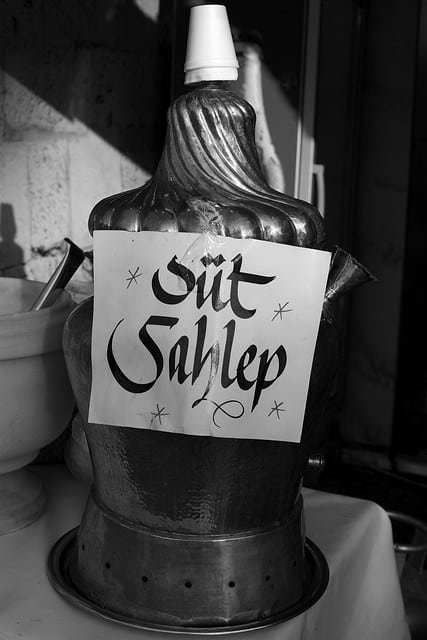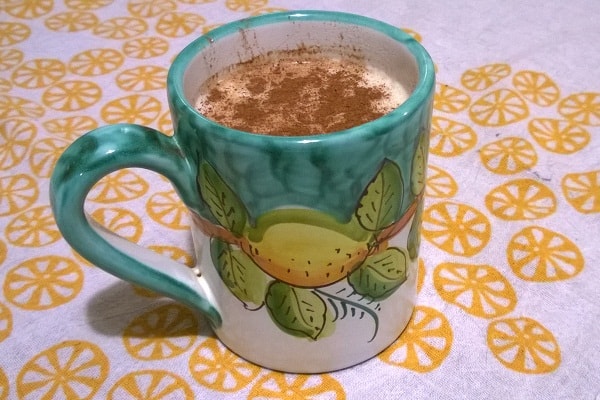With all the snow in Istanbul this winter, and the unforgettable sights it brought of children sledding, snowmen in coats, and seagulls waddling in it, sahlep has had even more seasonal appeal than usual. This milky, sweet, steaming drink dusted with cinnamon is nothing if not comfort food, and you can find it everywhere. Little “Sahlep” signs have popped up in dozens of cafes around the city, from Eyüp to Emirgan, from newly-hatched hipster cafes in Kadıköy to eminent 150-year-old venues like Kurukahveci Mehmet Efendi in Sultanahmet, not to mention ferry crossings and street vendor carts.

But the more I read about sahlep, the more convinced I became that most of what was being served was not the real thing. Rather, it’s a concoction that may include corn (or rice, potato, wheat) starch, guar gum, mastic, natural or artificial flavors, and maybe a very small percentage of sahlep. The first clue is price. True sahlep is made by grinding the tubers of orchid plants, and this powder is then mixed with milk and sugar over heat to produce the demulcent drink.
It takes about a kilogram of orchid tubors to make enough powder for one cup of sahlep, however, and these plants are not cultivated, so sahlep powder is pricey. Most harvesters of the tubors actually only take one bulb because then the plant can replace it. In this way the native orchid population is protected. For similar reasons it is illegal to export sahlep from Turkey, though my initial searches for the pure powder did turn up a bottle for sale on Amazon for nearly $300.
To be sure of its authenticity, I determined that I would need to track down the powder and prepare a batch myself. Turkish food writers advised me to look in the aktar or herb and spice stores in Istanbul. I found mine at the Arifoğlu Baharat store in the Kadıköy market for the price of 400 TL per kilogram. Sahlep began to take on an exotic allure, as if I were buying its weight in gold or an illegal substance. I got 50 grams and made off wondering what this rare, expensive flower dust would do. The color was surprising too, kind of a yellowish brown, rather like the color of fresh ginger.

Sahlep is actually a luxury, not unlike saffron, truffles, or caviar. The taste, however, may not be quite so exquisite. If anything the pure sahlep I made at home was even more bland and starchy than the commercially sold drinks, but it is partly this blandness that is so soothing (I also used less sugar than the typical cafe sahlep drinks). It’s the texture, both chalky and smooth at the same time, along with the flavor that is so appealing. My homemade sahlep also left no saccharine-sweet aftertaste and seemed to hold the heat longer.
To prepare it I combined two cups milk with a teaspoon each of sahlep powder and sugar, and stirred this over simmering heat until it thickened. This thickening happens remarkably quickly; sahlep is after all a natural starch. I sprinkled cinnamon on top and, voilà, I had the authentic, traditional drink.
Drinking something like sahlep is enjoyable in and of itself, but it is also about the connection to history and the cultural traditions of the region. Some sources say that sahlep was discovered by resourceful Ottomans looking for a hot drink that was non-alcoholic. For centuries, the powder from orchid roots has been touted for its health benefits, especially as a treatment for cold symptoms, sore throats, and indigestion. It was even seen as an aphrodisiac, especially for men. This probably has to do with the fact that the orchid bulbs, of which there are two, bear a resemblance to testicles. Its popularity spread to other countries as well—in England in the 17th century, it was known as saloop and working class men would drink it before beginning their shifts. This was all before coffee came along; both coffee and rakı later surpassed traditional drinks like sahlep and boza in popularity.
Luckily, sahlep has survived in all its thick milky wintry deliciousness. With the second homemade cup I made, the sore throat I had in the morning was gone by midday.
Where is your favorite place to get sahlep? Do you have any special tricks for making sahlep at home? Share your recommendations in the comments!
Zamira Skalkottas is a contributor to Yabangee.
Featured Image Source: KLGreenNYC / Foter / CC BY-SA










Interesting article! Are there cafes in the city that serve authentic sahlep?
[…] Focus on finding authentic sahlep to ensure we only drink the […]